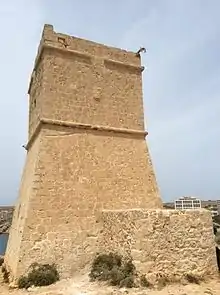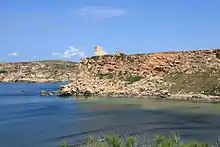Għajn Tuffieħa Tower
Għajn Tuffieħa Tower (Maltese: Torri t'Għajn Tuffieħa), also known as Għajn Mixkuka Tower (Maltese: Torri t'Għajn Mixkuka, sometimes spelt Mixquqa),[1] is a small watchtower in Għajn Tuffieħa, limits of Mġarr, Malta. It was completed in 1637 as the second of the Lascaris towers. The tower is in good condition.
| Għajn Tuffieħa Tower | |
|---|---|
Torri t'Għajn Tuffieħa | |
| Part of the Lascaris towers | |
| Mġarr, Malta | |
 Għajn Tuffieħa Tower | |
| Coordinates | 35°55′51.33″N 14°20′36.65″E |
| Type | Coastal watchtower |
| Height | 11 m |
| Site information | |
| Owner | Government of Malta |
| Controlled by | Gaia Foundation |
| Open to the public | Yes |
| Condition | Intact |
| Site history | |
| Built | 1637 |
| Built by | Order of Saint John |
| Materials | Limestone |
History

Għajn Tuffieħa Tower was built in 1637 on the cliffs overlooking Għajn Tuffieħa Bay close to Mellieħa and Mġarr on the northwest coast of Malta. The tower has Lippija and Nadur Towers in its line of sight.
The tower was designed by the Italian architect Vincenzo Maculani. It is almost identical to Lippija Tower, having a square plan and two floors topped by a flat roof with a parapet. Each floor has a single room, and access to the upper floor was originally by a wooden ladder.
Għajn Tuffieħa Tower was built on the site of a medieval watchpost.[2] It was originally armed with a ½-pounder gun, and its garrison consisted of a captain and three men, who were paid by the Università of Mdina.[3]
Present day

The tower was in poor condition until it was restored in 2000 with the support of the Director of Public Projects and Din l-Art Ħelwa. In 2012, vandals sprayed graffiti on two sides of the tower. This has been removed.[4]
The tower continued to be renovated by the Gaia Foundation, and it opened to the public in 2013 as part of a peace grove containing over 20 species of indigenous plants.[5]
The tower is threatened by coastal erosion, and cracks can be seen on the cliffs upon which the tower is built.[6] The terrain may be dangerous for risky walkers, when next to the cliffs, with some people having lost their life due to falls. Some incidents are investigated as it may potentially be used for voluntarily suicides.[7]
References
- Camilleri, Alex (2011). "It-Toponomastika ta' Malta: Il-Mellieħa u Madwarha" (PDF). L-Imnara (in Maltese). Għaqda tal-Folklor. 9 (4): 195. Archived from the original (PDF) on 17 April 2016.
- Zammit, Vincent (1984). "Fortifications in the Middle Ages". Civilization. Ħamrun: PEG Ltd. 1: 33.
- Debono, Charles. "Fortifications - Ghajn Tuffieha Tower". Mellieha.com. Retrieved 16 September 2014.
- Carabott, Sarah (20 July 2012). "Graffiti daubed across Knights' tower". Times of Malta. Retrieved 20 April 2014.
- "Għajn Tuffieħa tower now open to public". Times of Malta. 24 June 2013. Retrieved 20 April 2014.
- "Ghajn Tuffieha tower in danger of collapse". Times of Malta.
- "Man found dead at bottom of cliff". Times of Malta.